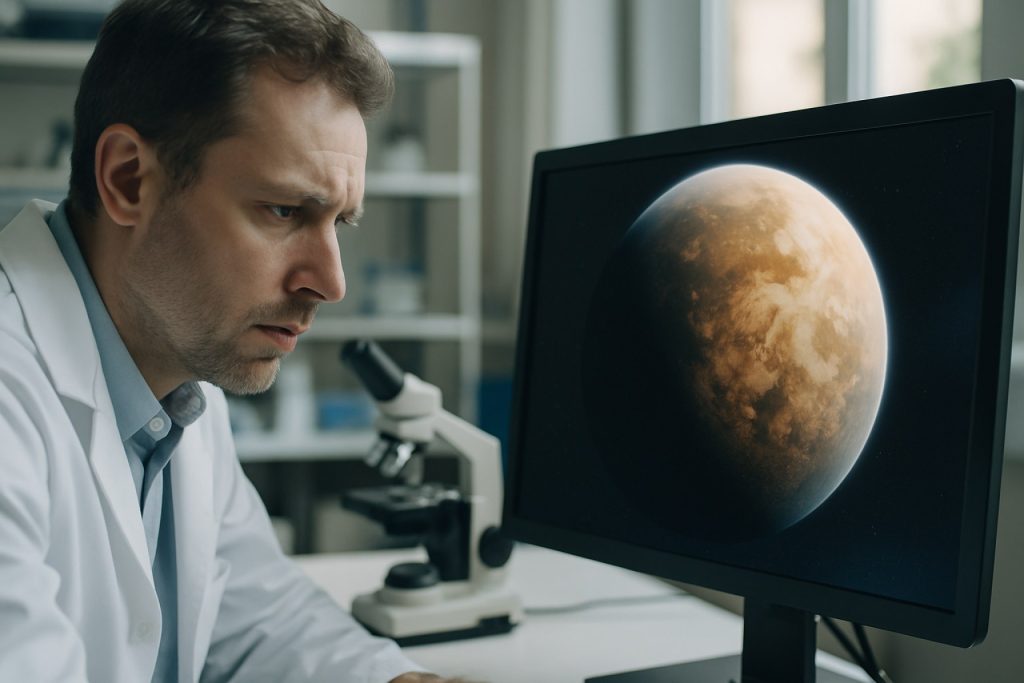
- A newly discovered Super-Earth, 137 light-years away in Virgo, orbits a red dwarf star in the habitable zone, where liquid water could exist.
- The planet is nearly three times Earth’s diameter, likely has a solid rocky surface, and is enveloped by a thick atmosphere.
- Evidence of oxygen and methane in its spectrum hints at complex atmospheric chemistry, sparking interest in possible life-supporting conditions.
- This Super-Earth stands out due to its Earth-like characteristics and short 17-day orbit, in contrast to giants like Jupiter.
- Ongoing and future telescopic studies will be crucial to deciphering its actual habitability and searching for signs of life.
Shrouded in the velvet darkness beyond our solar system, astronomers have identified a Super-Earth unlike any previously seen, raising hopes for breakthroughs in our understanding of potentially habitable worlds. Perched 137 light-years away in the constellation Virgo, this planet, with a diameter nearly three times that of Earth, orbits a cool red dwarf star. The cosmic find crackles with possibility.
Sky-watchers tracked the gentle dimming of starlight, unveiling a world both alien and familiar. Unlike our gas giants, this globe likely boasts a solid, rocky surface veiled by swirling clouds—a landscape perhaps more reminiscent of Earth than Jupiter. Yet, the planet’s higher gravity and thicker atmosphere promise weather cycles and vistas that would stretch the imagination of even the most seasoned exoplanet watchers.
What truly sets this world apart is its position in the so-called “habitable zone,” the temperate swath around its star where temperatures might allow water to flow—a necessity for life as we know it. While dozens of exoplanets have already earned the “Super-Earth” label, few promise this combination: a high probability of a rock-hard surface, a cloak of thick air, and a year (single orbit) that unfolds over just 17 days.
Oxygen and methane signatures etched in its light spectrum whisper tantalizing hints—a possibility of atmospheric chemistry complex enough to intrigue astrobiologists. Yet, scientists urge patience. Many challenges lie ahead: future telescopes must untangle the truth of its skies, searching for the subtle fingerprints that living creatures might leave behind.
In the cosmic race to find another blue marble, every discovery sharpens our tools and our imaginations. This newfound Super-Earth reminds us that the universe is bursting with worlds waiting to be understood—and that the question of cosmic company grows ever more meaningful.
For the endlessly curious, the frontiers of astronomical exploration stretch on. To immerse yourself in the wonders of our universe and stay up to date on cutting-edge research, visit Nasa—and keep watching the skies.
Key takeaway: The detection of this mysterious Super-Earth catapults us closer to answering humanity’s oldest question: Are we alone, or do other living worlds await among the stars?
Super-Earth Discovery: Why This Strange, Rocky World Could Be Our Best Shot at Finding Alien Life
Introduction
Astronomers have recently identified a unique Super-Earth orbiting a cool red dwarf star 137 light-years away, in the constellation Virgo. With its potential for habitability and unprecedented characteristics, this planet is electrifying the scientific community and deepening our quest to find life beyond Earth. Here, we explore lesser-known facts, answer the pressing questions readers have, and give clear, actionable tips on how you can keep up with—and even contribute to—groundbreaking discoveries in exoplanet science.
—
Additional Facts Every Curious Mind Should Know
1. What Is a Super-Earth—And How Common Are They?
Super-Earths are exoplanets with masses between 1 and 10 times that of Earth, typically larger than Earth but smaller than gas giants like Neptune. While the term refers to size and mass, it does not guarantee that the planet is Earth-like in composition or environment. According to NASA, Super-Earths are among the most common types of exoplanets discovered so far—yet our solar system lacks one, making these objects especially intriguing (Nasa).
2. Why Red Dwarf Stars Matter
Red dwarf stars (also called M-type stars) are smaller, cooler, and longer-lived than our Sun and represent about 70% of all stars in the Milky Way. Planets orbiting in the habitable zone around red dwarfs have special significance because these worlds are easier to detect and study, making them prime targets for life-searching missions.
3. The Atmosphere: More Than Meets the Eye
This Super-Earth’s thick atmosphere could offer significant protection from stellar radiation—vital for life as we know it. However, a dense atmosphere can also create a runaway greenhouse effect, as seen on Venus. Understanding the balance of gases like oxygen, methane, and possibly carbon dioxide is essential for assessing true habitability.
4. Day Length and Weather Patterns
With a 17-day orbit, this exoplanet’s year is extremely short. It likely exhibits tidal locking—a phenomenon where one side always faces the star, creating extreme temperature differences between day and night sides. This could result in wild, unpredictable weather patterns, high winds, and spectacular cloud formations.
5. How Was This Planet Discovered?
Astronomers used the transit method, monitoring periodic dimming of starlight as the planet crossed in front of its host star. This technique is highly effective for detecting exoplanets, particularly those orbiting smaller, dimmer stars.
—
Real-World Use Cases and Industry Trends
– Exoplanet Atmosphere Research: With instruments like the James Webb Space Telescope, scientists can probe the atmospheres of distant worlds for biosignatures (“fingerprints” of life).
– Search for Life: Upcoming missions (e.g., ESA’s ARIEL) will focus on statistical studies of exoplanet atmospheres, further refining our understanding of what conditions allow for life.
– Citizen Science: Projects like Planet Hunters (Zooniverse platform) let amateur astronomers help spot exoplanet candidates—no PhD required!
—
Pros, Cons, Controversies, and Limitations
Pros
– Located in the habitable zone—a so-called “Goldilocks region.”
– Likely has a rocky surface and a thick, protective atmosphere.
– Short orbital period (17 days) makes it easier to study repeatedly.
Cons
– High gravity could challenge human or robotic exploration.
– Thick atmospheres may obscure surface details and complicate biosignature detection.
– Tidal locking could limit habitable regions to a narrow “twilight belt.”
Controversies & Limitations
– The true composition of the atmosphere is currently speculative; confirmation requires more data.
– Dense clouds could mask signs of life or make surface mapping nearly impossible.
– High radiation from occasional flares (common in red dwarfs) may threaten biological stability.
—
Features, Specs, and Predictions
– Diameter: ~3 × Earth’s diameter
– Host Star: Red dwarf (M-dwarf)
– Distance: 137 light-years away
– Atmospheric Composition: Possible oxygen and methane detected (pending confirmation)
– Surface: Likely rocky with dynamic weather patterns
– Year: 17 Earth days
– Predicted Habitability: Promising, pending further study of atmospheric chemistry and stellar activity
—
Expert Opinions & Market Forecast
Astrobiologists like Dr. Sara Seager (MIT) highlight the promise of Super-Earths around red dwarfs for hosting life: “These are the low-hanging fruit in the hunt for habitable exoplanets” [source: Nasa]. The global exoplanet research market is expected to grow as new space telescopes, improved data analysis, and AI-driven discovery methods continue to advance.
—
FAQs and Pressing Questions Answered
Q: Could we ever visit this planet?
With current technology, reaching a planet 137 light-years away is far beyond our grasp. However, detailed atmospheric analysis, robotic exploration with advanced probes, and even laser-propelled “Starshot” concepts are the subject of ongoing research.
Q: How will scientists confirm signs of life?
The discovery depends on identifying chemical imbalances—like simultaneous oxygen and methane—in the planet’s atmosphere, which could indicate biological activity. Upcoming telescopes with advanced spectrometers will be critical to this challenge.
Q: How can the public get involved?
Join citizen science platforms like Zooniverse or follow trusted sources for discovery updates, such as Nasa.
—
Quick Actionable Tips
– Stay updated: Bookmark and visit authoritative science sites like Nasa for real-time exoplanet news.
– Join the search: Contribute to crowdsourced data analysis through citizen science projects.
– Educate yourself: Read up on the James Webb Space Telescope and ESA’s ARIEL mission for upcoming exoplanet studies.
– Stay skeptical: Remember, the presence of oxygen and methane alone doesn’t guarantee life—critical peer review and further data are essential.
—
Conclusion
The discovery of this Super-Earth in Virgo is a major leap in our cosmic quest for habitable worlds. As telescopes grow more powerful and data pours in, the prospect of discovering alien life—or a second Earth—feels closer than ever. Stay curious, join the adventure, and keep watching the skies.
For the latest cosmic discoveries and expert insights, remember to visit Nasa—your gateway to the universe.



